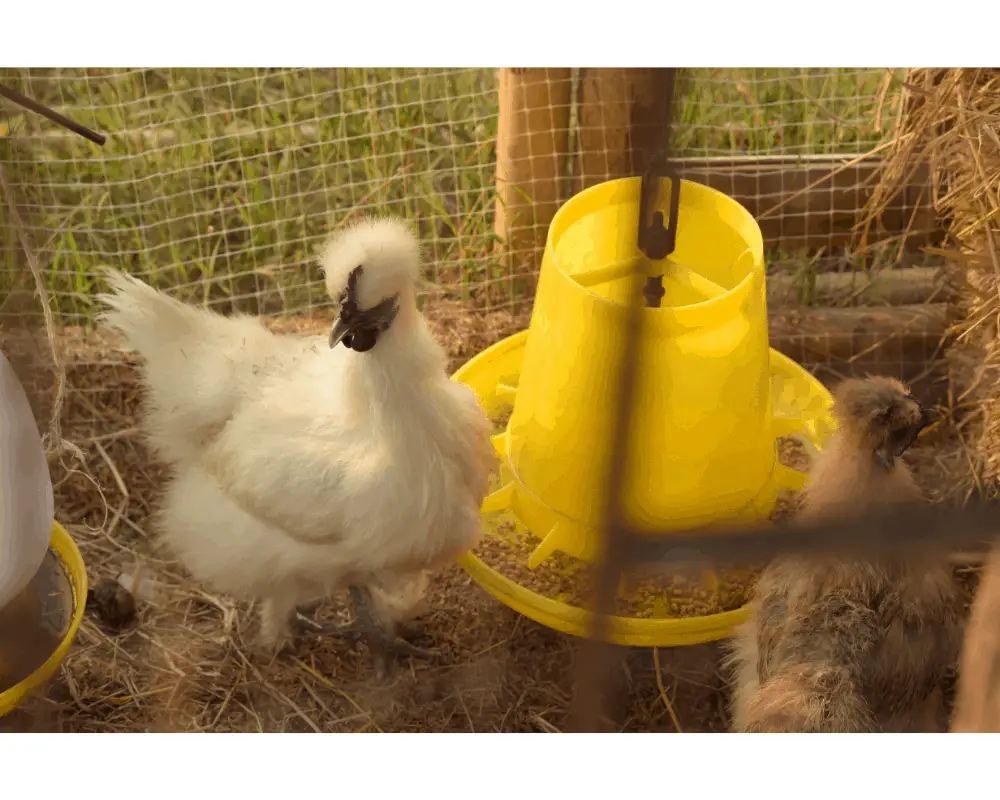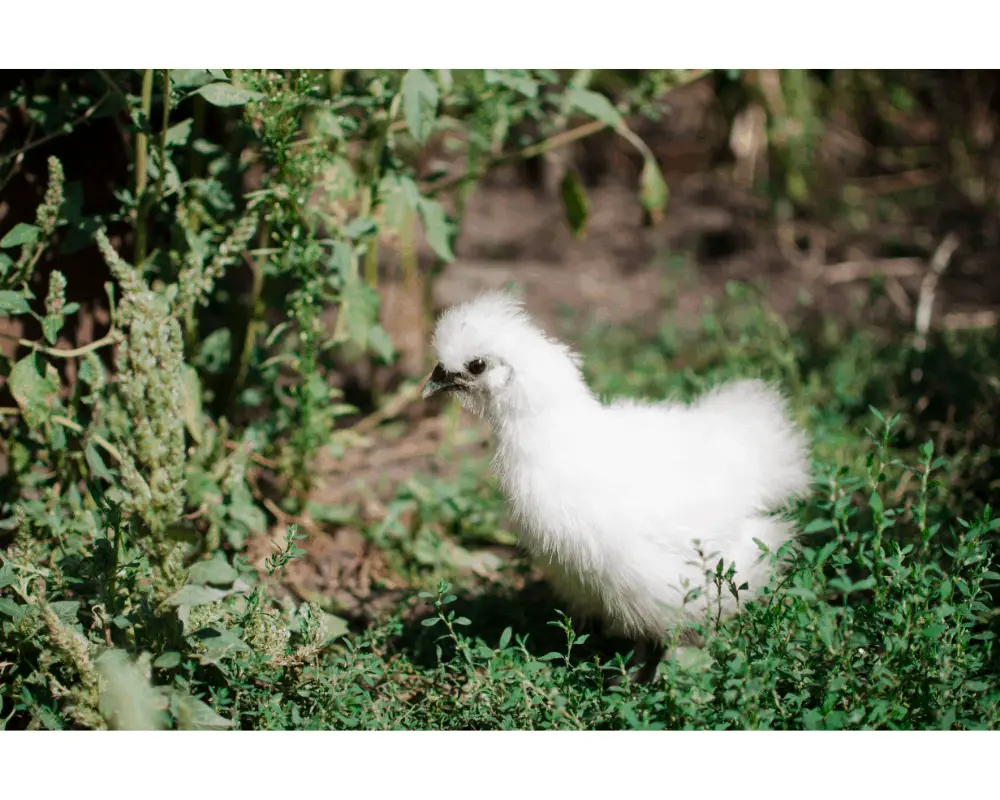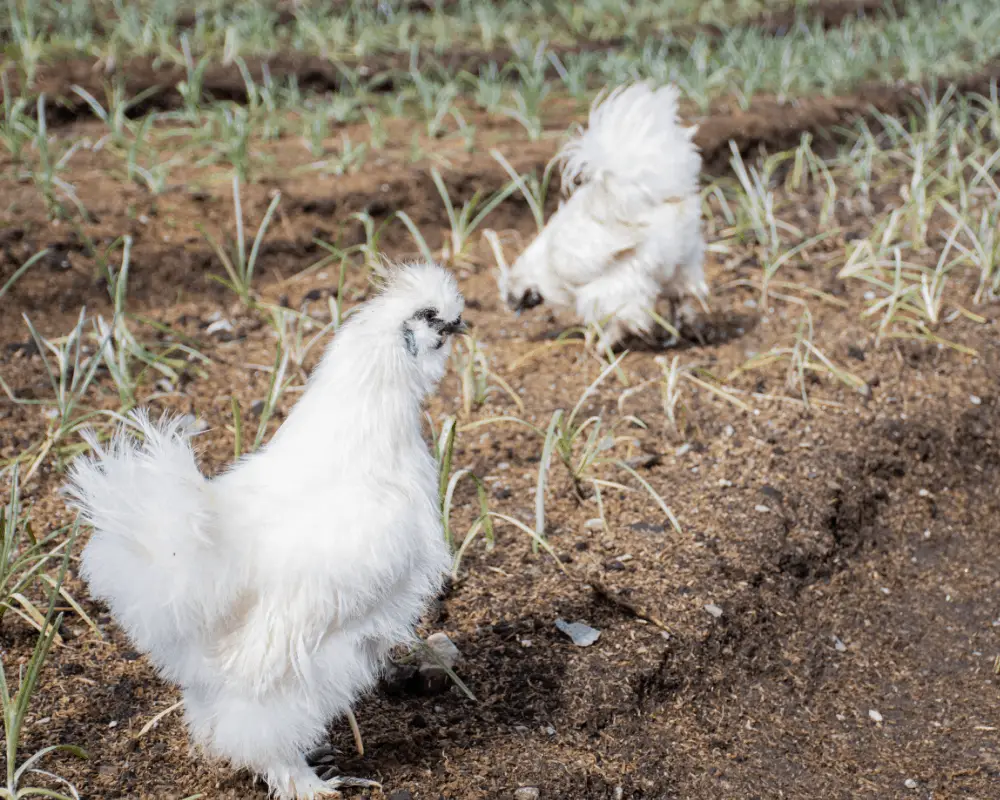This article contains affiliate links, and we may earn a commission at no cost to you if you choose to purchase through these links. I never recommend products that I do not trust or will not advise my veterinary clients and patients to use.
Although Silkies have similar nutritional requirements compared to other chicken breeds, there are a few things to consider that make silkies as unique as their appearance when it comes to their diet.
Silkie chickens are omnivores, thus they need a combination of plant materials such as grains, vegetables, seeds, and grass as well as some insects and other animal protein sources such as eggs. The largest part of their diet must consist of grains and pulses with the occasional extra protein source.

Silkies enjoy having a very varied diet and will spend a large portion of their time foraging. Even if given a complete feed, silkies will seek out fresh plant material and insects while free-ranging. The main thing to consider when feeding silkies is the amount of protein and grit they need in different life stages.
Silkie chicks, for example, need a chick starter up to 8 -10 weeks of age which is higher in protein compared to usual chicken feed. Silkie hens usually start laying around 5 months old and at this stage a layer feed higher in calcium would be ideal. These can usually be bought from a feed store but there are some recipes available to make your own Silkie feed. Allowing your silkies time to free-range will ensure that they get a good amount of grit to aid digestion as well as extra protein.
It can be quite daunting to be faced by the wide variety of chicken feed available on the market and you might be wondering whether your silkies need something in addition to the usual chicken feed. Read on to find out exactly what a balanced silkie diet looks like as well as what you can give as treats and what supplements they need.

What and how to feed your backyard Silkies
There are few things to keep in mind that makes feeding Silkies slightly different from feeding other chicken breeds. For one, silkies will have some difficulty picking up and swallowing the large layer pellets and if you decide to go the commercial mix route, it will be worth spending roughly 2% extra on the short cut layer pellets.
Ideally, Silkies must be allowed time to free range in your backyard. This way, they will naturally seek out the extra greenery, grit, and insects they need. If silkies are kept in a coop exclusively, it will be u to you to provide them with all the components of a varied healthy diet.
A note on feeding eggs as this is something that will be mentioned a few times in this article and can be somewhat controversial: I am a proponent of feeding chickens cooked egg as a treat every so often as it is an easily accessible, incredibly high-quality source of protein and vital nutrients. Eggshells can act as an excellent grit and a source of calcium. Chickens will naturally often consume the contents and shell of eggs that broke. So no, your Silkies are not cannibals because they eat chicken eggs, it simply fits like a puzzle piece to fill a gap in a Silkie chicken’s diet by providing them with a complete amino acid profile as well as important B vitamins needed to grow and produce eggs. Cooked eggs are easily picked up and swallowed and cooking prevents salmonella contamination and potentially sick birds. So before you scrap the idea of feeding eggs, just consider the tremendous health benefits it has for your silkies.
Grit
Since chickens don’t have teeth (I’ve heard that hen’s teeth are quite hard to come by), they usually ingest small pebbles or other indigestible hard material. This will stay in the gizzard (a chicken’s stomach) and help to grind down food particles into smaller, more easily digestible pieces. Small chicks do not need grit and chick crumbs usually do not contain grit (we discuss this in more detail in the chick section below). Some commercial feed mixes already contain grit, usually in the form of milled oyster shells. Grit can also act as a source of important minerals such as calcium and magnesium. This can be especially important for example in a laying hen to produce good quality eggshells.
Whether you need a feed that contains grit depends largely on the area where your chickens are roaming. If they are kept in a coop only (which I do not advise as free-ranging has many benefits that extend far beyond the obvious nutritional benefits), you will definitely need to either add grit to their feed or buy feed that contains added grit. Back yard roaming chickens can usually find their own grit outdoors but providing them with some commercially bought grit every now and then, will be beneficial.
Feeding according to life stage
0 – 8 weeks
Hatchlings can survive for 2 days after hatching on the nutrients derived from the egg yolk alone, but you can offer them chick starter crumbs from day one. They have higher protein (18-20%) and energy requirements than adult chickens and it will be best to stick to a good quality chick starter such as MannaPro Non-medicated starter crumble feed. Starter feed does not contain grit. Chicks this young need a diet consisting mainly of highly digestible feed and grit will only fill their crops with unnecessary indigestible material that will limit intake of digestible nutrients and eventually limit growth. Your hen can happily enjoy some starter feed along with her chicks while tending them.
It is also important to supply your chicks with fresh water daily in a shallow bowl that they won’t be able to tip because if they can, they will! And that will lead to them soaking themselves as well as everything around them.
If newly hatched chicks seem like they do not know how to peck, tapping the crumbles in a pecking motion with your finger can sometimes help them get the hang of it.
In summary, a good practical feeding schedule for this age group would be starter crumble with the addition of some finely grated carrots and greens such as iceberg lettuce daily and finely chopped hard-boiled eggs every second day. Make sure they have clean water- chicks can be quite messy so check the water bowl at least twice a day.
9 – 20 weeks
Chicks of this age can be introduced to a courser grain mix as well as some grit. A commercial grower can be a good option as long as the pellets/crumbles are small enough for them to swallow. In addition to the grated carrots, greens, and hard-boiled eggs you fed them prior to this age, you can add a grain and yogurt mix as an occasional treat (recipe below).
Hens
Silkie hens do well on a layer-specific feed. Even though they are not high producing layers (they produce roughly 100 eggs per year which are low compared to the 250 of layer breed hens), a layer feed contains enough of everything she needs. At this stage, they are also pretty good at finding extra snacks around the garden. Below is a recipe for a homemade layer mix.
In addition to the daily small particle-sized layer mix, you can add a commercial oyster shell grit every second day. A mealworm treat egg scramble can be given 2 times a week. Leaving some of the eggshells in the mix can act as grit too.
Roosters
A rooster’s needs do not particularly different from that of the adult hens and he can happily join the hens on the layer mix. Since silkie roosters are slightly larger than the hens, they will happily pick up larger pellets as well.
Winter feeding
Silkies need higher calorie feed in winter as well as higher protein to support their pre-winter molt. You can add high protein treats such as eggs or mealworms to their diet more regularly during winter. Shelled or husked sunflower seeds, cooked wheat, still warm in the mornings, and sprouted seeds are excellent winter treats. The greens they usually get fee ranging may not be as readily available during winter so it is a good idea to grow some greens of your own indoors that you can add to their daily feeding in winter. Examples of easily grown greens are:

What treats can I give to my Silkies?
Giving treats is a lovely way to bond with your silkies and it is also very useful to tame more timid birds. Treats should make up no more than 10 % of their diet. Giving too many treats or giving treats too often will lead to them consuming less of their usual diet and potentially becoming deficient in some essential nutrients and not to mention, your silkies getting into the bad habit of begging every time they see you. Also, keep in mind that some roosters may start crowing in anticipation of treats if this becomes a habit. It goes without saying that this behavior is one best avoided, especially for silkies living in a suburban area.
Below is a list of common tasty treats and how often they can be safely fed to your silkies.
| Treat | Benefit | How often to feed |
|---|---|---|
| Milled corn | High in energy | Every 3-4 days |
| Grated carrots | High in beta carotene – will help to produce eggs with bright yellow egg yolks | Daily |
| Mealworms | High in Protein | Every 3-4 days. Can be given more often in colder months |
| Scramble eggs/chopped hard-boiled eggs | High in protein. If you add pieces of eggshell to the mix, it can be a useful source of grit | Every 3-4 days. Can be given more often during colder months |
| Leafy greens such as iceberg lettuce, cabbage, parsley, dill, mint, and oregano | High in vitamin c, deep green leaves also contain high levels of beta carotene | Daily |
| Yogurt | High in protein. Keep portion sizes small as silkies have limited ability to digest lactose | Not more than 3 times a week |
| Shelled or husked sunflower seeds | High in energy | Every 3-4 days during the colder months |
| Frozen peas or sweetcorn | High in beta carotene and vitamin c. Excellent treat during summer | Every other day |
| Cat kibble | High in energy and protein | Every 3-4 days during the colder months |
| Watermelon or other melons | High in water-soluble vitamins | Every 3-4 days |
| Milled corn | High in energy | Every 3-4 days |
| Watermelon | High in water-soluble vitamins – the perfect summer treat. Silkies love this! | Every other day |
What are Silkies not allowed to eat?
Although silkies chickens may seem to like to peck at nearly anything and everything, there are a few things that should best be avoided. Below is a list of common household foods that your silkies won’t thank you for.
| Food to avoid | Toxic effect |
|---|---|
| Avocado | Persin causing acute heart failure |
| Uncooked beans | Haemagglutinin is a toxic principle that causes blood clots. If you want to feed beans, soak it in cold water for 5 hours, rinse, and boil rapidly for 30 minutes as the toxin is destroyed by heat |
| Chocolate | Theobromine contained in cocoa, as well as caffeine, causes irregular heartbeats and potentially cardiac arrest |
| Anything with mold on it | Many species of mold produce toxins that can severely affect the liver of birds |
| Green potatoes or green tomatoes | Contains a Nero-toxin causing drowsiness, paralysis, and eventually death |
| Apple seeds | Although apple flesh is completely safe, apple seeds contain cyanide which prevents the red blood cells from taking up oxygen |
What supplements do Silkies need?
Apart from the already mentioned special requirements, you may wonder whether adding a vitamin and mineral supplement will be worth it. In my opinion, as long as silkies have a varied diet based on a good commercial food either starter for the chicks or layer for the adults, in addition to free-ranging in a garden where they have access to some fresh greens and insects, they should be getting all they need. As mentioned before, it will be worth adding some extra protein and upping the amount of feed given around the colder months.
If you are keeping silkies for egg production, there is some interesting research done on the supplementation of spirulina on the nutritional value and flavor of silkie eggs. Chen et. al. published an article in the Journal of Animal Physiology and Animal Nutrition in 2019 that showed that silkies that were supplemented with Spirulina at 3% of their total weight of food consumed per day had a significant increase in egg production and nutritional value and flavor of the eggs. If you are especially interested in silkies for their eggs, it might be worth considering adding spirulina to their diet. This will best be implemented by giving approximately 1.8-3 grams of spirulina per silkie hen to their daily feed or, in other words, 10-13g per pound of food.
Another interesting fact worth mentioning with regards to supplementation and egg production is that the color of the yolk is determined by the amount of beta carotene in their diets. If you like to have bright yellow egg yolks, you can add fresh greens and carrots to your silkies’ diet.
How much feed do silkies need and can you feed a silkie too much?
Silkies rarely overeat and I have never heard of an obese silkie. An overweight silkie is extremely uncommon! What we should rather be concerned about, is giving too many treats which will lead to under-eating of their balanced ratio that may lead to some nutrient deficiencies and subsequent health problems. As a general guideline, stick to feeding your silkies roughly 60 – 100 grams per adult silkie per day.
Recipes for Silkie feed
Home Made Layer Mix
This mix is best fed to free-ranging silkie chickens that have access to greens. This recipe is for 10 pounds of feed, so feel free to double up or halve the recipe according to your flock size. The mix keeps well for a month in a cool, dry, and air-tight container.
- 3.2 ounces of small cut layer pellets (layer mash or flakes also work well)
- 3.2 ounces of oats
- 3.2 ounces of wheat
- 3.2 ounces of split maize
- 0.8 ounce of safflower seeds
- 0.8 ounce of hulled sunflower seeds without the shells
- 0.8 ounce of flax seeds
- 0.3 ounce of buckwheat or hemp seed
- 0.3 ounce of grit (milled oyster shell works well but granite grit is a good alternative)
- 0.4 ounce of Brewer’s yeast powder (great source of b vitamins and may help to reduce manure odor)
- 0.4 ounce of garlic powder (has antibacterial properties and may help to reduce manure odor)
- 0.4 ounce of seaweed (decreases the microbial load in the digestive system)
- 0.4 ounce of spirulina (increases egg production as well as nutritional value and flavor of eggs)
This mix can be fed daily as a daily scratch at 60-100 grams per adult silkie.
Yogurt Treat
This is a good treat, especially given in supplementation to chicks in the 9-20 week category. Just keep in mind that silkies have a limited ability to digest lactose, but the probiotics and protein derived from the yogurt hold many benefits.
This can safely be given half a tablespoon per bird up to 3 times a week as a treat.
- 8 ounces of low fat plain yogurt
- 3 ounces of milled corn
- 1 ounce of hemp seeds
- 2 ounces of shelled or husked sunflower seeds
Feel free to add other treat ingredients to the yogurt to create your own treat mix according to what you have available.
Other treats to consider is cooked wheat given while still warm on winter mornings or watermelon on summer days. Your silkies will love you for this!
As the saying goes, the way to a silkie’s heart is through their belly. By feeding nutritious feed, your silkies will more than return the favor by remaining happy and healthy and providing you with many years of joy.

